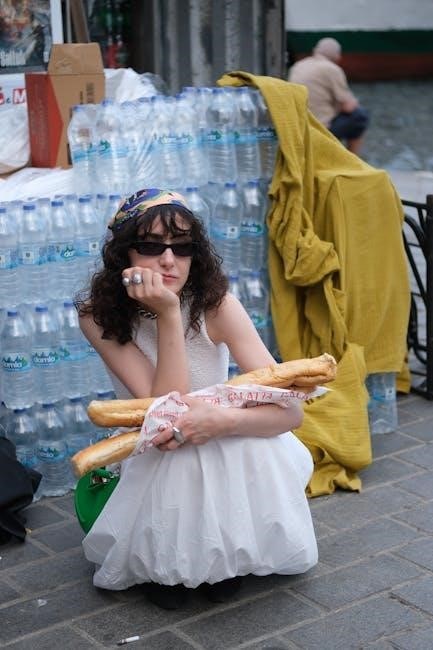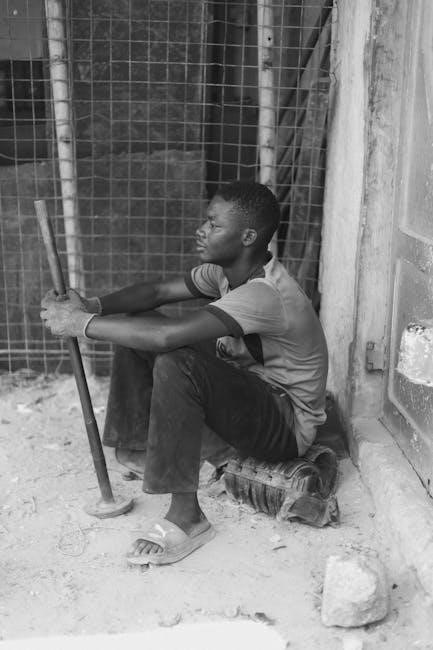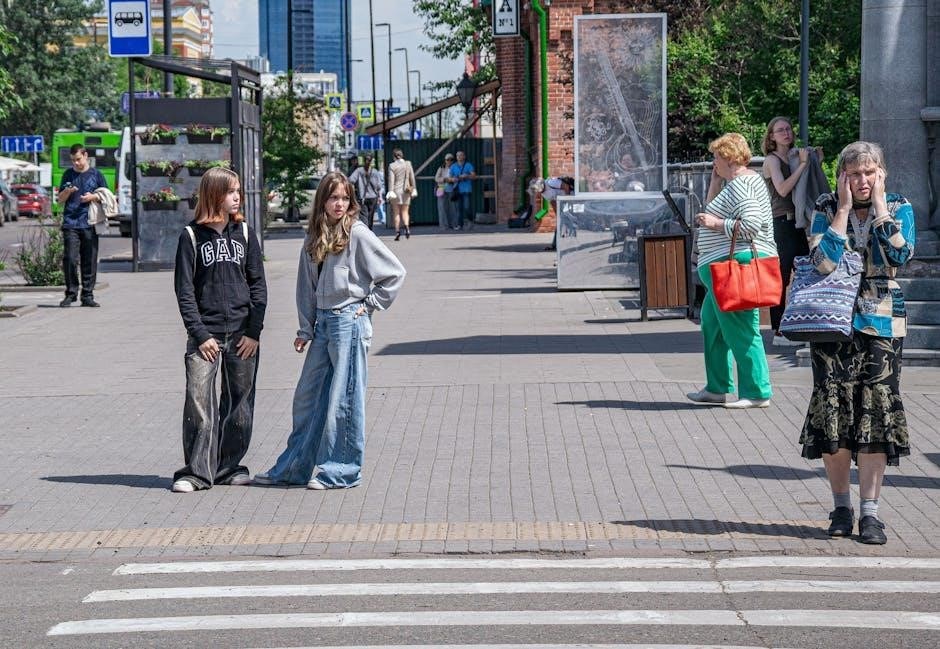Waiting for Godot, written by Samuel Beckett, is a landmark play in absurdist theatre, exploring themes of existence, hope, and despair through two characters endlessly waiting.
Overview of the Play
Waiting for Godot is a two-act play centered around Vladimir and Estragon, two men endlessly waiting for someone named Godot. Their dialogue is circular, filled with uncertainty and absurdity. Secondary characters, Pozzo and Lucky, appear, adding depth to the narrative. The play’s structure is cyclical, with repeated actions and no resolution, emphasizing the futility of waiting. Godot never arrives, leaving the characters—and audience—in ambiguity. This absurdity reflects existential themes, questioning life’s purpose and meaning. The play’s minimalistic setting and repetitive dialogue underscore its exploration of human existence, hope, and despair. Its enigmatic nature has made it a cornerstone of absurdist theatre, sparking endless interpretations.
Historical Context of the Play’s Creation
Waiting for Godot was written by Samuel Beckett between 1948 and 1949, a period marked by post-World War II existential crises and philosophical shifts. The play reflects the absurdity and uncertainty of life, resonating with the intellectual climate of the time. Beckett, influenced by existentialism and absurdism, crafted a work that challenged traditional theatre norms. Initially performed in Paris in 1953, it garnered confusion but soon became a cornerstone of absurdist literature. The play’s creation coincided with a global reckoning with meaninglessness, making its themes of waiting and futility deeply relevant. Its historical context underscores its enduring influence on modern theatre and philosophy.
Themes and Symbolism in “Waiting for Godot”
Central to Waiting for Godot are themes of existentialism and absurdism, highlighting the futility of human existence. The play’s symbolism, such as the tree and rope, underscores the cycles of life and death. Characters like Vladimir and Estragon embody hope and despair, while Pozzo and Lucky represent exploitation and societal hierarchy. The elusive Godot symbolizes the unknown, mirroring humanity’s search for meaning. Beckett’s use of dialogue and setting reinforces the play’s themes, creating a sense of timelessness and universal relevance. These elements collectively explore the human condition, making the play a profound reflection on existence and its inherent ambiguities.

Key Themes Explored in “Waiting for Godot”
The play delves into existentialism, absurdism, and the futility of waiting, exploring human hope, despair, and the search for meaning in an uncertain world.
The Concept of Waiting and Its Significance
Waiting in Waiting for Godot symbolizes the human condition’s inherent uncertainty. Vladimir and Estragon’s endless wait for Godot embodies existential limbo, reflecting life’s ambiguity and the search for meaning. Their anticipation underscores the futility of expecting external salvation, highlighting the absurdity of prolonged hope without resolution. This concept challenges audiences to confront the possibility that fulfillment may never arrive, mirroring real-life struggles with purpose and expectation. The play’s cyclical structure reinforces the idea that waiting becomes an end in itself, rather than a means to an end, profound commentary on human existence’s inherent ambiguity and resilience.
Existentialism and the Absurd
Waiting for Godot epitomizes existentialism and the absurd, exploring life’s inherent meaninglessness. Beckett’s play portrays Vladimir and Estragon in a futile wait, symbolizing humanity’s search for purpose in an indifferent universe. The characters’ repetitive actions and circular dialogue highlight the absurdity of existence, emphasizing the lack of clear meaning or resolution. Their struggles to find purpose in a seemingly meaningless world reflect existentialist themes of freedom and responsibility. The play’s absurdist elements challenge conventional narrative structures, mirroring the chaos of life. Through this lens, Beckett critiques traditional notions of purpose, leaving audiences to ponder the significance of their own existence and the inevitability of uncertainty.
The Role of Hope and Despair
In Waiting for Godot, hope and despair intertwine as central emotional currents. Vladimir and Estragon’s endless wait for Godot symbolizes hope’s persistence, even in uncertainty. Their cycles of anticipation and disappointment reveal the human condition’s fragility. Despite the futility of their wait, they cling to hope as a survival mechanism, embodying existential resilience. Yet, despair lurks in their repeated failures and the bleakness of their environment. Beckett uses their interactions to show how hope and despair coexist, offering a poignant commentary on the human condition. The play captures the tension between longing for meaning and the inevitability of uncertainty, leaving audiences to reflect on their own struggles with hope and despair.

Major Characters in the Play
Estragon and Vladimir are the central figures, embodying a complex friendship. Godot, the elusive figure they await, remains unseen, while Pozzo and Lucky add depth to the narrative.

Estragon: Character Analysis
Estragon, often referred to as “Gogo,” is a complex and dynamic character in Samuel Beckett’s Waiting for Godot. He is known for his emotional volatility and physical discomfort, frequently expressing frustration and despair. Estragon’s interactions with Vladimir reveal a deep, albeit strained, friendship. His forgetfulness and reliance on Vladimir highlight his dependence, while his occasional bursts of anger and resignation underscore his struggle with their endless waiting. Estragon’s character serves as a reflection of the human condition, grappling with uncertainty and the search for meaning in a seemingly meaningless world.
Vladimir: Character Analysis
Vladimir, often called “Didi,” is the more philosophical and introspective of the two main characters in Waiting for Godot. He is driven by a persistent hope and a need to find meaning in their endless waiting; Vladimir often acts as the voice of reason, attempting to make sense of their situation and recalling past events. His interactions with Estragon reveal a deep concern for his friend, despite their frequent quarrels. Vladimir’s character embodies the human spirit’s resilience and the struggle to maintain hope in the face of uncertainty, making him a central figure in exploring the play’s themes of existence and absurdity.
Godot: The Enigmatic Figure
Godot remains an enigmatic figure throughout the play, never appearing on stage but deeply influencing the characters’ actions and hopes. His absence is central to the narrative, symbolizing the elusive and unknowable nature of meaning in life. The characters’ endless waiting for Godot reflects humanity’s search for purpose and divine intervention. Despite numerous interpretations, Godot’s identity and intentions are left ambiguous, adding to the play’s mystique and philosophical depth. His presence is felt through the characters’ anticipation and despair, making him a powerful symbol of the unknown and the unattainable.
Pozzo and Lucky: Their Role in the Play

Pozzo and Lucky are pivotal characters who interrupt Vladimir and Estragon’s waiting. Pozzo, a tyrannical figure, controls Lucky with a rope, symbolizing power dynamics and exploitation. Their interactions highlight themes of domination and submission. Lucky’s nonsensical monologue in Act I contrasts with Pozzo’s arrogance, showcasing the absurdity of human communication. In Act II, Pozzo returns blind, and Lucky mute, emphasizing the cyclical nature of existence and the characters’ inevitable decline. Their presence underscores the futility of human endeavors, reinforcing the play’s absurdist tone and the idea that meaning is elusive, even as characters cling to their routines and relationships.

Symbolic Elements in the Play
The tree symbolizes existence, the rope signifies desperation, and the desolate setting reinforces the narrative’s bleakness, highlighting the characters’ emotional and philosophical struggles effectively.

The Tree as a Symbol of Existence
The tree in Waiting for Godot stands as a poignant symbol of existence, embodying both desolation and subtle transformation; Bare and lifeless in Act I, it sprouts leaves by Act II, suggesting faint hope or cyclical time. Its presence grounds the play’s abstract themes, mirroring the characters’ existential struggles. The tree’s endurance, despite its bleakness, reflects humanity’s resilience amidst uncertainty. Its minimal change underscores the futility of waiting, yet offers a glimmer of continuity in an otherwise absurd world. This duality makes the tree a powerful metaphor for the human condition, resonating deeply with the play’s exploration of meaning and existence.
The Rope and Its Implications
The rope in Waiting for Godot symbolizes the characters’ existential despair and futile attempts to escape their predicament. Estragon and Vladimir contemplate using it for suicide, reflecting their hopelessness. The rope represents a tangible means of escape, yet it remains unused, highlighting their paralysis. Its presence underscores the absurdity of their situation, as they oscillate between resolve and indecision. The rope also signifies the cyclical nature of their existence, as they repeatedly consider and dismiss it. This object becomes a metaphor for the human condition, trapped between despair and the inability to act, mirroring the play’s broader themes of absurdism and existential struggle.
The Setting and Its Impact on the Narrative
The setting of Waiting for Godot is a desolate, barren landscape with a single tree, creating an atmosphere of isolation and timelessness. This minimalistic backdrop emphasizes the universality of the themes, as the lack of specific details about time and place detaches the story from reality. The tree, which changes subtly between acts, serves as a symbol of existence and the passage of time. The stark environment mirrors the emotional and philosophical void of the characters, highlighting their existential struggles. The setting’s simplicity forces the audience to focus on the characters’ dialogue and interactions, underscoring the play’s themes of absurdity and the search for meaning in a seemingly meaningless world.

Structure and Style of the Play
Waiting for Godot features a cyclical structure with repetitive dialogue, emphasizing absurdity and existential themes. Its minimalist style and lack of resolution create a profound, unsettling impact.
The Cyclical Nature of the Play
The cyclical nature of Waiting for Godot is evident in its repetitive actions and dialogue, creating a sense of timelessness. Each act mirrors the previous, with Vladimir and Estragon trapped in an endless loop of waiting for Godot, who never arrives. This structure reflects the futility of their existence and the inevitability of repetition in life. The cyclical pattern emphasizes the absence of progress or resolution, leaving the characters, and the audience, in a state of perpetual uncertainty and existential limbo. The play’s circularity underscores its themes of absurdity and the search for meaning in a seemingly meaningless world.
Lack of Resolution and Its Purpose
The absence of resolution in Waiting for Godot is a deliberate choice by Beckett to reflect the absurdity of human existence. The play ends with Vladimir and Estragon still waiting for Godot, leaving their fate unresolved. This lack of closure mirrors the futility of seeking definitive answers in life. By denying the audience a satisfying conclusion, Beckett underscores the themes of uncertainty and the search for meaning in a seemingly indifferent world. The unresolved ending challenges viewers to confront existential questions and the possibility that some questions may remain unanswered. This ambiguity is central to the play’s enduring philosophical impact.
Language and Dialogue in the Play
The dialogue in Waiting for Godot is characterized by its simplicity, absurdity, and repetitive nature. Beckett uses everyday language to explore profound existential themes, creating a sense of realism within an absurd framework. The conversations between Vladimir and Estragon often circle back on themselves, highlighting the futility of their situation. The dialogue also employs silence and pauses effectively, emphasizing the characters’ emotional states and the void they inhabit. Pozzo and Lucky’s interactions contrast sharply, with Pozzo’s authority and Lucky’s incoherent monologues adding layers of complexity. The language underscores the play’s themes of uncertainty and the search for meaning in a chaotic world.

Cultural and Literary Impact
Waiting for Godot revolutionized theatre, inspiring absurdist literature and influencing countless writers. Its exploration of existential themes remains culturally relevant, shaping modern interpretations of human existence and uncertainty.
Influence on Absurdist Literature
Waiting for Godot is a pioneering work in absurdist literature, redefining storytelling by embracing ambiguity and existential themes. Beckett’s play inspired a wave of absurdist writers, shaping the genre’s identity. Its minimalist dialogue and absurd situations challenged traditional narrative structures, encouraging experimentation in literature. Playwrights like Eugène Ionesco and Harold Pinter drew inspiration from its non-linear format and exploration of human futility. The play’s influence extended beyond theatre, impacting fiction and philosophical discourse. Its enduring relevance lies in its ability to reflect the chaos and uncertainty of modern life, making it a cornerstone of absurdist literature.
Reception and Interpretations Over Time
Since its 1953 premiere, Waiting for Godot has sparked diverse interpretations and debates. Initially, audiences found its minimalist, absurdist style confusing, but it soon became a landmark of existentialist theatre. Critics have interpreted the play as a reflection of post-war existential despair, while others see it as a metaphor for the human condition. Over the decades, its themes of waiting, uncertainty, and the search for meaning have resonated universally. The play’s ambiguity has led to countless analyses, ensuring its relevance across generations. Its influence on theatre and literature remains profound, with its PDF versions widely studied for insights into its themes and structure.
Modern Relevance of the Play
Waiting for Godot remains remarkably relevant in today’s world, resonating with themes of existential uncertainty and the search for meaning. Its exploration of waiting as a metaphor for human existence aligns with modern anxieties about time, purpose, and fulfillment. The play’s absurdist style reflects the chaos and unpredictability of contemporary life, offering a universal message that transcends time and culture. Its themes of hope, despair, and the cyclical nature of existence continue to provoke thought, making it a timeless work. The availability of the play in PDF format ensures its accessibility, allowing new generations to engage with its profound insights and timeless questions.

Availability and Access to “Waiting for Godot” in PDF Format
“Waiting for Godot” in PDF format is widely available through online libraries, eBook platforms, and official publishers. Ensure legal access by purchasing or downloading from authorized sources.
Where to Find the PDF Version
The PDF version of “Waiting for Godot” can be found on various online platforms, including academic databases, eBook stores, and literary websites. Many universities and libraries offer free access to the play in digital formats for educational purposes. Additionally, platforms like Google Books, Project Gutenberg, and official publishers provide downloadable versions. Some websites may require purchase or subscription, while others offer free access to the text. Always ensure that the source is legal and respects copyright laws. For convenience, popular eBook retailers like Amazon and Barnes & Noble also offer the play in PDF format for download. Verify the source’s authenticity to avoid unauthorized versions.
Legal and Ethical Considerations for Downloading
When downloading the PDF version of “Waiting for Godot”, it is crucial to respect copyright laws and intellectual property rights. Ensure the source is legal and authorized to distribute the work. Downloading from unauthorized websites may violate copyright and support piracy, which is unethical. Always opt for reputable platforms or purchase directly from official publishers to support the author and the literary community. Additionally, many educational institutions provide access to the play through their libraries, offering a legal and ethical alternative. By choosing legal options, you contribute to the preservation of literary works and uphold ethical standards in digital content sharing.
